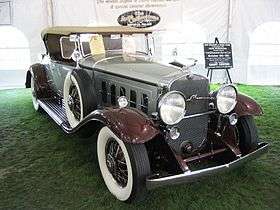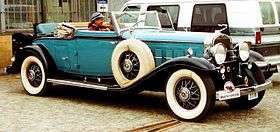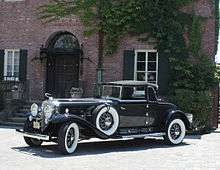Cadillac V-16
| Cadillac V-16 | |
|---|---|
 | |
| Overview | |
| Manufacturer | General Motors |
| Production | 1930–1940 |
| Assembly | Detroit, Michigan, United States[1][2] |
| Designer | Harley Earl |
| Body and chassis | |
| Class | Full-size Luxury car |
| Body style |
2-door convertible[1][2] 4-door convertible[1][2] 2-door coupe[1][2] 4-door sedan[1][2] 4-door town car[1][2] 4-door limousine [1][2] |
| Layout | FR layout[1][2] |
| Platform | D body |
| Powertrain | |
| Transmission | 3-speed synchromesh manual[1][2] |
The Cadillac V-16 (sometimes known as the Cadillac Sixteen) was Cadillac's top-of-the-line car from its January 1930 launch until production ceased in 1940 as the war in Europe reduced the sales. All were finished to custom order, and the car was built in very small numbers; only 4076 cars were constructed in the eleven years the model was offered. The majority of these were built in the single year of 1930, before the Great Depression really took hold. This was the first V16 powered car to reach production status in the United States.
Genesis
In 1926, Cadillac began the development of a new, "multi-cylinder" car. A customer requirement was seen for a car powered by an engine simultaneously more powerful and smoother than any other available. Development proceeded in great secrecy over the next few years; a number of prototype cars were built and tested as the new engine was developed, while at the same time Cadillac chief Larry Fisher and GM's stylist Harley Earl toured Europe in search of inspiration from Europe's finest coachbuilders. Unlike many builders of luxury cars, who sold bare chassis to be clothed by outside coachbuilding firms, General Motors had purchased the coachbuilders Fleetwood Metal Body and Fisher Body to keep all the business in-house. Bare Cadillac chassis could be purchased if a buyer insisted, but the intention was that few would need to do so. One Cadillac dealer in England, namely Lendrum & Hartman, ordered at least two such chassis in even rarer right hand drive (RHD) configuration and had Vanden Plas (Belgium) build first an elegant limousine-landaulet (engine #702297), then a sports sedan with unusual cycle fenders and retractable step plates in lieu of running boards (engine #702298, which was successfully shown in various Concours d'Elegance events in Europe before being bought by the young Nawab of Bahawalpur); both these cars have survived. A third RHD chassis was ordered by the Indian Maharaja of Orccha (Bhopal) and sent to Farina in Italy, in July 1931, for a boat tail body (engine between #703136 and #703152).[3]
It was not until after the stock market crash of 1929 that Cadillac announced to the world the availability of the costliest Cadillac yet, the new V-16. The new vehicle was first displayed at New York City's automobile show on January 4, 1930.
1930–1937
| Generation 1 (Series 452 and 90) | |
|---|---|
 | |
| Overview | |
| Model years | 1930–1937 |
| Body and chassis | |
| Platform | Series 90: D-body |
| Related |
Cadillac Series 370/85 Cadillac Series 355 Cadillac Series 75 |
| Powertrain | |
| Engine | 452 cu in (7.4 L) Cadillac V16 |
| Dimensions | |
| Wheelbase |
1930–31: 148.0 in (3,759 mm)[1][2] 1932–33: 143.0 in (3,632 mm) and 149.0 in (3,785 mm)[1][2] 1934–37: 154.0 in (3,912 mm)[1][2] |
| Length |
1930–31: 222.5 in (5,652 mm)[1][2] 1932–33: 216.0 in (5,486 mm) and 222.0 in (5,639 mm)[1][2] 1934–35: 240.0 in (6,096 mm)[1] 1936–37: 238.0 in (6,045 mm)[1][2] |
| Width |
1931: 73.6 in (1,869 mm) 1932–35: 77.0 in (1,956 mm) 1936–37: 74.4 in (1,890 mm) |
| Height |
1931: 72.5 in (1,842 mm) 1932–33: 71.5 in (1,816 mm) 1934–37: 69.5 in (1,765 mm) |
| Curb weight | 5,300–6,600 lb (2,400–3,000 kg) |
The new car attracted rave reviews from the press and huge public attention. Cadillac started production of the new car immediately. January production averaged a couple of cars per day, but was then ramped up to twenty-two cars per day. By April, 1,000 units had been built, and by June, 2,000 cars. These could be ordered with a wide variety of bodywork. The Fleetwood catalog for the 1930 V-16 included 10 basic body styles; there was also an envelope containing some 30 additional designer's drawings. Research by the Cadillac-La Salle Club, Inc. puts at 70 the number of different job/style numbers built by Fisher and Fleetwood on the sixteen chassis.
Beginning in June 1930, five new V-16s participated in a promotional tour of major European cities including Paris, Antwerp, Brussels, Amsterdam, Utrecht, Copenhagen, Stockholm, Berlin, Cologne, Dresden, Frankfurt, Hamburg, Munich, Nuremberg, Vienna (where they won prizes), Berne, Geneva, Lausanne, Zürich, Madrid, San Sebastian, La Baule and Angers. On the return journey from Spain, the V16 caravan stopped also in the town of Cadillac, in south-western France, although that city bears no relationship to the marque, other than its name.
After the peak in V-16 orders in mid-1930, production fell precipitously. During October 1930, only 54 cars were built. The lowest figures for the 452/452A cars of 1930–31 were August 1931 (seven units) and November 1931 (six units). Minimum production continued throughout the rest of the decade with a mere 50 units being built both in 1935 and in 1937. 1940 was only marginally better with a total of 51 units. Not surprisingly, Cadillac later estimated that they lost money on every single V-16 they sold.
Production of the original V-16 continued under various model names through 1937. The body was redesigned in 1933 as the model 452C. Innovations included Fisher no draft individually controlled ventilation (I.C.V. or vent windows).
For 1934, the body was redesigned again and denoted as 452D, and as 452E in 1935. The V-16 now featured the Fisher Turret Top all-steel roof, though the cars were still built by Fleetwood. This same basic design would remain virtually unchanged through 1937. With a wheelbase of 154.0 inches (3,912 mm) and a curb weight of up to 6,600 pounds (3,000 kg) these are perhaps the largest standard production cars ever produced in the United States. Combined production for the 1934 and 1935 model years was 150. It was redesignated the Series 90 in 1936 as Cadillac reorganized their model names. Fifty-two units were sold that year, with nearly half ordered as limousines. Hydraulic brakes were added for 1937, the last year of production. Fifty vehicles were produced.
.jpg) 1930 Cadillac Series 452 Sport Phaeton
1930 Cadillac Series 452 Sport Phaeton 1930 Cadillac Series 452 Madame X
1930 Cadillac Series 452 Madame X 1931 Cadillac Series 452A 2-door convertible
1931 Cadillac Series 452A 2-door convertible 1932 Cadillac Series 452B
1932 Cadillac Series 452B 1932 Cadillac Series 452B Dual Cowl Phaeton
1932 Cadillac Series 452B Dual Cowl Phaeton 1932 Cadillac Series 452B coupe
1932 Cadillac Series 452B coupe.jpg) 1934 Cadillac Series 452D 4-door convertible
1934 Cadillac Series 452D 4-door convertible.jpg) 1934 Cadillac Series 452D 4-door convertible rear
1934 Cadillac Series 452D 4-door convertible rear- General Douglas MacArthur's 1937 Cadillac Series 90 town car
1938–1940
.jpg)
| Generation 2 (Series 90) | |
|---|---|
|
| |
| Overview | |
| Model years | 1938–1940 |
| Body and chassis | |
| Platform | D-body |
| Related |
Cadillac Series 75 Buick Limited |
| Powertrain | |
| Engine | 431 cu in (7.1 L) Cadillac V16 |
| Dimensions | |
| Wheelbase | 141.0 in (3,581 mm) |
| Length | 222.0 in (5,639 mm)[1] |
| Width | 77.6 in (1,971 mm) |
| Height | 69.6 in (1,768 mm) |
| Curb weight | 5,200–5,700 lb (2,400–2,600 kg) |
The V-16 "Series 90" and V-12 "Series 80 and 85", were essentially merged for 1938 with the introduction of the new L-head V-16. The new engine was an "L Head" (AKA flathead) design, and featured a wider (135 degree) v-angle, twin carburetors, twin fuel pumps, twin distributors, twin water pumps, and a nine main bearing crankshaft (compared to the OHV V-16's five bearing crank) and produced the same 185 hp (138 kW) as later versions of the original V-16 with even greater smoothness and endowed the '38–'40 Sixteens with the swiftest acceleration of any car in the world at the time regardless of weight as well as slightly improved fuel economy over the OHV V-16 cars. This engine was nearly silent at idle and turbine-smooth in operation. The wheelbase was reduced to 141.0 in (3,581 mm), the body remained 222.0 in (5,639 mm) in overall length. The "Sixteens" (as Cadillac referred to them) were basically series 75 cars with the new V-16 engine although they differed from the firewall forward from the V-8 cars and had several other trim differences. The instrument panels were identical to and changed yearly with the V-8 cars from 1938 to 1940. Only the '38 Sixteens had a horn button which had "Sixteen" in art deco script; the '39 and '40 models, like the V-8, had the Cadillac crest on the button. Three hundred fifteen were sold in the first year, 138 in the next. The production of the 1940 models ended in December 1939.
Engines
Two different V-16 engines were used by Cadillac:
- The Series 452 from 1930 until 1937, a narrow 45° V angle OHV (overhead valve) engine that displaced 452 cubic inches (7.4 liters).
- The Series 90 from 1938 to 1940, a lower, wider 135° V angle L-head (in-block valve) engine that displaced 431 cubic inches (7.1liters).
Cadillac V-16s today
The Cadillac V-16 is today recognized as one of the finest automobiles of the prewar era by many authorities. The Classic Car Club of America rates all V-16s as CCCA Full Classics, a rating reserved for only the finest automobiles of the 1925–1948 period. Values reflect these opinions; particularly fine examples of the 1930 production can change hands for more than US$500,000 as of 2004. As always, convertibles are the most valued, and the earlier cars more so than the 1938–40 vehicles. A good condition 1938 sedan can sell for under US$80,000. Certain custom-bodied vehicles have sold for even more.
Concept car
In 2003, Cadillac created a concept car called the Sixteen, which used a 13.6 litre V-16 engine that developed 1,000 bhp (746 kW; 1,014 PS). Even though it used the current "A&S" (Art & Science) style of design that is Cadillac's stylistic hallmark, it shared many small details from the classic V-16. The Sixteen is also known to have the steering wheel logo carved out of solid crystal and a Bulgari clock.
See also
References
Notes
- 1 2 3 4 5 6 7 8 9 10 11 12 13 14 15 16 17 Kimes, Beverly (1996). Standard catalog of American Cars 1805–1942. Krause publications. ISBN 0-87341-428-4.
- 1 2 3 4 5 6 7 8 9 10 11 12 13 14 15 Gunnell, John (2005). Standard Catalog of Cadillac 1903–2005. Krause publications. ISBN 0873492897.
- ↑ http://cadillacdatabase.org/Dbas_txt/V6srv30b.htm
Bibliography
- Holmes, Mark (2007). Ultimate Convertibles: Roofless Beauty. London: Kandour. pp. 42–43. ISBN 978-1-905741-62-5.
External links
- Yann Saunders and the Cadillac-LaSalle Club, Inc. (1996–2004). The (new) Cadillac Database©: The Cadillac V16. Retrieved May 23, 2004 from http://cadillacdatabase.org/Dbas_txt/V16_ndx.htm.
- "Sixteen-Cylinder Motor Latest Auto Wonder" Popular Mechanics, March 1930 article on first Cadillac V-16 engine
- 1938 Cadillac V16 for sale from http://www.usedcarsgroup.com/used-1938-cadillac-v16-saint_louis-mo-388124984369755693
| Cadillac vehicle timeline, 1930s–1970s — next » | ||||||||||||||||||||||||||||||||||||||||||||||||||
|---|---|---|---|---|---|---|---|---|---|---|---|---|---|---|---|---|---|---|---|---|---|---|---|---|---|---|---|---|---|---|---|---|---|---|---|---|---|---|---|---|---|---|---|---|---|---|---|---|---|---|
| Type | 1930s | 1940s | 1950s | 1960s | 1970s | |||||||||||||||||||||||||||||||||||||||||||||
| 0 | 1 | 2 | 3 | 4 | 5 | 6 | 7 | 8 | 9 | 0 | 1 | 2 | 3 | 4 | 5 | 6 | 7 | 8 | 9 | 0 | 1 | 2 | 3 | 4 | 5 | 6 | 7 | 8 | 9 | 0 | 1 | 2 | 3 | 4 | 5 | 6 | 7 | 8 | 9 | 0 | 1 | 2 | 3 | 4 | 5 | 6 | 7 | 8 | 9 | |
| Mid-size | WWII | Seville | ||||||||||||||||||||||||||||||||||||||||||||||||
| Entry-level | 60 | 61 | 61/63 | 61 | ||||||||||||||||||||||||||||||||||||||||||||||
| 65 | 62 | Series 62 | 62 | 62 | Calais | Calais | ||||||||||||||||||||||||||||||||||||||||||||
| Full-size | de Ville | de Ville | de Ville | de Ville | de Ville | |||||||||||||||||||||||||||||||||||||||||||||
| 353 | 355 | 70 | 60S | Series 60S | Fleetwood Brougham | |||||||||||||||||||||||||||||||||||||||||||||
| Limousine | 353 | 355 | 67/72/75 | Series 75 | 6700 | Series 75 | FL Limo | |||||||||||||||||||||||||||||||||||||||||||
| Halo | V-12 | |||||||||||||||||||||||||||||||||||||||||||||||||
| V-16 | 70 | Eldorado Brougham | ||||||||||||||||||||||||||||||||||||||||||||||||
| Personal Luxury | Eldorado | Eldorado | Eldorado | Eldorado | Eldorado | Eldorado | Eldorado | Eldorado | ||||||||||||||||||||||||||||||||||||||||||